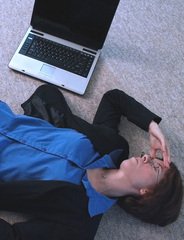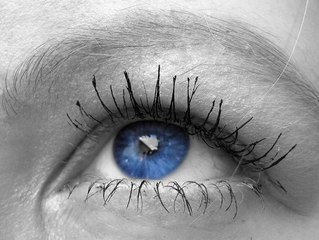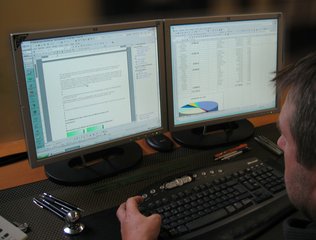Protect Yourself While Using Your Computer
Protect Yourself While Using Your Computer
Article by Dr. Terry Kibiloski
PROTECT YOURSELF
Two common health risks for computer users are:
• computer vision syndrome
• carpal tunnel syndrome
Computer Vision Syndrome
If you are a computer user and experience blurred vision, dry eyes, eye twitching, eye discomfort, headaches, neck and shoulder pain, and red eyes, you may have Computer Vision Syndrome (CVS). A survey conducted by the Industrial Design Center, Indian Institute of Technology (IIT), shows that video display terminals (VDT), or computer work, is strenuous and leads to complex eye and vision problems. According to PubMed Central® (PMC) at the U.S. National Institutes of Health’s National Library of Medicine, nearly 60 million people worldwide suffer from Computer Vision Syndrome (CVS). The American Optometric Association defines CVS as a mix of eye and vision problems related to “near work,” experienced during computer usage.
The IIT study found that computer work is visually demanding, with the eye shifting and focusing between the screen, document, and keyboard 25,000 times a day. The eye must accommodate, converge, and adapt to these tasks under varying light of the VDT, the report said. This task is equivalent to subjecting the eyes to 60 push-ups a minute. Another study conducted by the Department of Human Factors Engineering, University of Occupational and Environmental Health, Japan, said that visual strain occurred after merely 60 minutes of VDT tasks, which further resulted in lower productivity. While specially coated eyeglasses and anti-glare filters can reduce glare, there are other things you can do to reduce Computer Vision Syndrome:
- Reduce the blue light. You can do this by buying blue light shielding glasses. The best we found are at https://www.jandsvision.com/shop/computer-glasses/. We are not affiliated with this company and provide it only for information purposes. Or, if you have a Windows computer, click at the bottom left of your screen where it says, “Type here to search” and search for “Night light.” When you go to the Night light screen, click on Turn It On. This will reduce the blue light. You will notice the bright white turn a slightly duller shade. Since blue light can affect sleep, this is a great thing to do if you are on your computer at night to help you sleep better. At Computer Times, we keep the Night light on most of the time. If you are working with images, webcams, or anything else where you need to adjust coloration, be sure to turn the Night light off so you see the actual colors. When working with image/webcam coloration, we use blue light shielding glasses, instead of the Night light, so we can simply take off the glasses for any coloration adjustments on the screen.
- Reduce the source of the glare. Adjust the lighting in your computer workspace by experimenting with turning on and off various lights, and repositioning those that can be moved. You might also try a variety of bulbs in your lights to achieve a softer lighting scheme. Close your window curtains or blinds to keep out the sun’s glare. Reposition your computer monitor. You could also buy an inexpensive flat screen monitor that plugs into the monitor port of your desktop or laptop personal computer.
- Invest in a large, high-resolution flat screen monitor. This will provide better visibility by accommodating larger font sizes and clearer images. This is an especially good option if you are constantly working with spreadsheets or extremely fine drawings or artwork. Your goal is to decrease eye strain, and head and shoulder stress, by allowing yourself to sit with good posture, and view your monitor with its center point at eye level.
- Keep the monitor clean and free of dust, fingerprints, and smudges that can distort screen images. Never use water on your screen, or press into a flat screen monitor while cleaning, as this can damage the monitor’s ability to present well-focused images. Invest in a box of inexpensive lint-free cleaning cloths made especially for flat screen monitors and televisions.
- Rest and exercise your eyes at periodic intervals (every 20 minutes or so) by closing them for a few moments and then doing some refocusing exercises. The steps for refocusing exercises are as follows: Focus on an object close to your eyes (like a pencil or finger), focus on another object at arm’s length, then focus on an object at a distance, repeating several times. When focusing on an object at a distance, without moving your head, go through the cycle of focusing to the top left, then top center, then top right (top being the distant ceiling), continue the cycle of focusing to the center left, center, and center right (center being midway from ceiling to floor), then continue the cycle with bottom left, bottom center, and bottom right (bottom being near the floor). For example, focus on your finger as close to your face where you still have clear focus, then focus on a finger on your other hand at arm’s length, then focus at a distance to the top left, then reverse to focus on your finger at arm’s length, back to your finger close to your face, and close your eyes for a moment, and begin this cycle again changing the distant focus to the top center, and so on. This will give your eye muscles a good overall workout, focusing at many distances and points, to compensate for your lengthy fixed focusing on your computer screen.
- Discuss Computer Vision Syndrome with your ophthalmologist for further assistance and professional advice. It is important to have your eyes checked regularly to be sure that your blurred vision, dry eyes, eye twitching, eye discomfort, headaches, and red eyes, are not being caused by some physical eye disorder. It is especially important to have your eye pressure checked as high pressure can lead to a host of problems.
Another eye ailment mentioned by many computer users is red, irritated eyes. Studies have shown a decrease in blinking rate, plus wider opening of the eyes, when using a computer. This can result in fewer tears and greater tear evaporation, thus causing dry, irritated eyes. To relieve this problem, you may want to take frequent breaks, blink more, use mild eye drops, and maintain proper room humidity. A good temporary relief for tired, aching eyes, eye strain, burning and redness is the Similasan Computer Eye Relief sterile eye drops, which are formulated with natural active ingredients.
Carpal Tunnel Syndrome
Another major area of concern, many times associated with excessive computer use, is repetitive stress injury (RSI). The most common form of RSI for computer users is called carpal tunnel syndrome. The carpal tunnel is a narrow passageway in the wrist through which nine tendons and the median nerve runs, which gives feeling to the hand. Many believe that with repetitive typing motion, the carpal tunnel tendons swell, and then compress and damage the sensitive median nerve, causing carpal tunnel syndrome. Keeping the wrists straight and using ergonomic aids may help prevent this condition.
Some doctors recommend expensive surgery to help fix the problem in severe cases. Unfortunately, some patients have found the surgery to be ineffective in solving the problem. Research suggests monitor position and posture, rather than repetitive motion, causes carpal tunnel syndrome. Are we treating symptoms and not the cause?
Position of Head, Not Wrist Action, Causes Carpal Tunnel Syndrome
According to some experts who specialize in computer workstation ergonomics, the improper placement of computer monitors causes the debilitating hand and arm injury that affects thousands of computer workers each year, commonly diagnosed as carpal tunnel syndrome (CTS). One author has gone as far as to say constant strain on the neck from viewing improperly placed monitors 40 hours a week would cause CTS, even if the computer user never typed a single word.
Classic CTS symptoms are pain, numbness, and tingling in the hand, which can progress to a weakened grip and severe pain in the forearm or shoulder. CTS can worsen to the point where the nerves die. If this happens, the person’s dysfunction of the hand or hands is irreversible, even with surgery.
What you may not realize is CTS also affects piano and violin players, hairdressers, knitters, telephone operators, cigar rollers, and grocery store clerks. Besides using their hands in repetitive motions, these workers all have prolonged periods of looking down in common, which can cause CTS, according to Julia Lacy, author of a book in its second printing, How to Survive Your Computer Workstation (CRT Services, 1990).
Lacy says her conclusions come from surveys of several thousand full-time computer users over a four-year period. Her theory is that looking down pitches the head forward, placing strain on the neck muscles, which in turn spasm. These spasms aggravate the nerve that emanates from beneath the seventh vertebra of the cervical spine from the C7/C8 nerve root area, which is connected to the median nerve. This eventually causes the symptoms associated with CTS.
“The head,” says Lacy, “weighs as much as a bowling ball. Imagine the extra work neck muscles must do when the head moves off its natural pivot atop the shoulders,” Lacy said. “When monitors are set too low,” Lacy continues, “neck muscles must hold up a very heavy head, clamping down with a vice-like grip on the C5-TI area, home of nerves found along the arm. Eventually these exceedingly tense nerves spasm, shooting pain down the arm and into the wrist and hand, where ultimately their branches terminate.”
Dr. David Glick, an independent researcher for the Richmond, Virginia-based company Neural Function Analysis, said his company agrees with Lacy’s theory on CTS. Glick, who had never heard of Julia Lacy, said his survey of 496 people with CTS symptoms revealed only seven had damage in the wrist area. The overwhelming majority, 442, had neck injury in the C8 through T1 cervical area, 28 had neck and wrist injuries, 14 had shoulder injuries, and 5 had other miscellaneous problems.
According to this research, computer workstation users can protect themselves from CTS by making sure they do not have to bend their head, even slightly, to view the monitor. Not every user can simply move the monitor up to eye level and correct the problem. Glick said moving the monitor down may be the best way for those who have lost the normal cervical curve of the spine since sitting upright could cause those users problems.
Currently the medical profession still seems to focus on the wrist, with everything from splints to surgery. Before you have any intervention on your wrist, if you suffer from CTS symptoms, you may want to test Glick and Lacy’s theory for yourself. A simple change in posture at your PC could save you a lot of pain and future expense.








